► A cross-channel Honda Type R road trip
► Driving the rev-happy hot hatch icons
► From Integra to Civic, via Accord
Happy birthday, Honda Type R; the Japanese badge synonymous with shrieking VTEC hot hatches and coupes turns 25 years old this year, in a timeline stretching from the first NSX to the upcoming Civic.
In the UK we’ve enjoyed five red-badged Hondas – from 1998’s Integra and Accord to three shapes of Civic – and on the whole they were sublime. Few other mainstream performance brands can boast a better hit rate over a similar timescale.
What better way to celebrate this unbroken run of winners than with a drive to Paris in Honda UK’s pristine heritage fleet to see some other old cars at Retromobile? A word of warning though – some of these Type Rs can now be found for dangerously small money. Read on at your (bank balance’s) peril…
Peterborough to Dover: Accord Type R

If you grew up in the late 1980s or ’90s then the arrival of the eye-catching Integra coupe in 1998 would have coincided with your peak childhood fast-car interest, and later in life you may even have coveted a fast Civic or two as a result.
The Accord – the lesser spotted UK Type R – is a little too successful at flying under the radar. Those souped-up repmobile looks were overshadowed in Honda dealerships by the rarer-groove Integra, which (cruelly) was on sale at the same time.
As with all good things the passage of time has been kind to the Accord, plus the absence of boggo versions chuntering up and down the motorway only nowadays helps the Type R stand out now as a bona fide modern classic.
Business-like interior
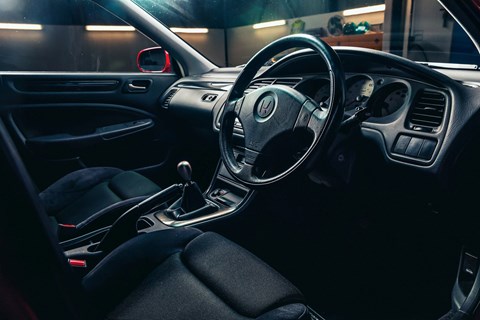
Step inside and there are only a few visual clues to separate this car apart from the standard one – a set of grippy Recaro buckets, an elegantly thin Momo wheel, and a set of racy white dials – the latter featuring an enticing ‘9’ at the end of the tacho.
The driving position feels high and there’s no in/out reach adjustment for the steering wheel, so if you’re tall it’s likely that 2-3000rpm on the rev counter will be obscured. Mind you, the engine shouldn’t be languishing there other than having just left the driveway.
The Accord actually boasts a fist-full of Top Trumps among the naturally aspirated Type Rs: its 2.2-litre engine is the largest, has the most torque, and the highest power output from the lowest revs.
A lusty 209bhp from 7200rpm might not sound low, but it’s barely above tick-over in Type R terms. This means although it has the slowest 0-62mph time at 7.5 seconds, it feels very pokey and flexible at low speed.
Then the VTEC kicked in…

All in all it’s a great gateway drug to full VTEC addiction – the engine comes on-cam with a punt rather than roundhouse and you’ll be chasing the redline through first, second and most of third before seeing motorway speeds. It’s easy to overdo a heel-and-toe downshift thanks to the razor sharp throttle response and appetite for revs, and as you’d expect the gearshift is super tight and accurate, with a longish throw and metal knob that feels icy cold on start up.
The handling is surprisingly focused for what is ostensibly a spiced-up saloon, largely thanks to a helical LSD which makes the most of the grip offered up by the front tyres. Chatty steering is heavy at low speeds but soon slackens off, retaining a strong tug of self-centring in a long corner, and revealing a sweet chassis balance with decent sticking power even in the wet.
Most impressive however is the ride, which on a late-night blast to an overnight stop in Kent proved very comfortable. Visibility out, however, is a mixed bag. Thin A-pillars and big windows make for great forward and sideways views, but in the rear mirror all you can see is wing. Even by today’s standards the Accord’s spoiler is large, and teamed with the low-slung twin exhaust system, made it the car everyone in our convoy wanted to follow. What a view.
Dover to Paris: Civic Type R (FK2)
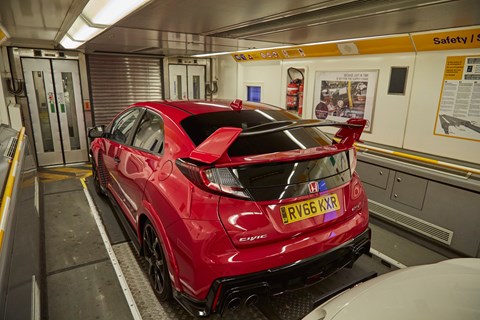
Our choice of the most modern car for the boring, early morning French motorway slog seemed inspired at first, but the error of our ways soon became apparent while boarding the Eurotunnel. This car is seriously wide, and its painted-on tyres offer little protection for those enormous alloys against the daft kerbs in the train. Why does a train need kerbs?!
Out the other side and on the mercifully smooth Autoroute, the Civic feels a different car than it does on the lumpy tarmac our side of the channel. All the jiggliness in the ride has gone and even in the stiffer R+ mode, you could almost call it compliant. In the UK you avoid this setting at your peril, unless you’re a glutton for spinal punishment or have a large stock of soon-to-expire chiropractic vouchers.
On mercifully wider roads the Civic settles down as a great long-distance companion. You can change the digital speedo to kph, it’s got cruise control, and the automatic air conditioning keeps the temperature just so.
Blast away the past

It’s also much faster than its older companions, making a mockery of their naturally aspirated engines at the tollbooth grand prix. The 2.0-litre displacement isn’t anything special among this company but the turbocharger attached means 306bhp, considerably more than the model it replaces.
Sprinting from 0-62mph in 5.7sec (nearly a full second quicker than anything else here) is impressive enough but it’s the whacking great 295lb ft of torque from 2500rpm that sets this car apart from its forebears. Other than some converging LEDs in the dashboard to announce the approaching redline, there’s no real encouragement to work the engine hard like in the other four cars – the noise and ferocity isn’t the same, unless you’re stood outside the car. It’s all a bit too easy.
It’s an enigmatic hot-hatch, the FK2, and that’s all part of its charm. For all our love of it on the motorway and winding roads (more on those later) there was an equal amount of spite and annoyance on the cobbles of Paris, and narrow multi-storey hotel car park. Let’s put it kindly – this Civic Type R is not a city car, even if the dozens of Parisians snapping themselves stood next to it while we were waiting in traffic would disagree.
Paris to Rouen: Civic Type R (FN2)
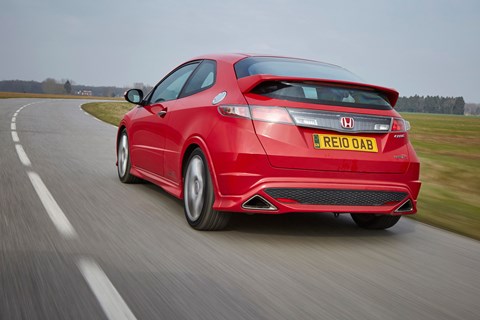
Here it is – Honda’s difficult third album. It was never going to be easy following on from the superb EP3 Civic Type R and the JDM-only EK9, and in terms of performance there’s little difference to the car it replaces (200-odd bhp, 142lb ft of torque, 6.6 seconds to 62mph). This being a 2010 model though, you do at least get a limited-slip differential.
Visually it looks heavier than the svelte EP3 and the interior plays a strange trick of seeming both futuristic in its design and a bit dated in its materials, like the graphics in an old Atari spaceship game. It’s still an alien craft inside and out though, this thing, and out of all the cars here looks the most distinctive.
On the aforementioned cobbles and cracked tarmac it’s also mercifully softer than the FK2 Civic (although still not exactly S-Class comfortable) and doesn’t thump around as much. Rearward vision is awkward thanks to the spoiler running along the boot glass, but the digital speedo and massive tacho are easy to spot (from Mars).
On the open road
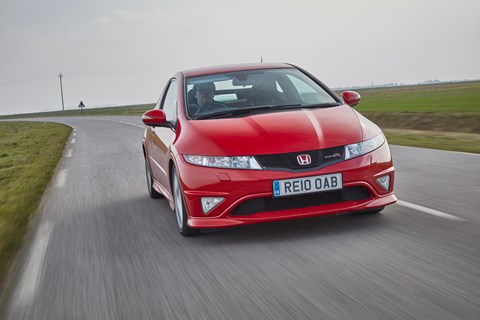
In the city the FN2 is no more challenging to drive than a standard Civic and after a while it starts to feel a bit ordinary. With a bit of space (and rural northern France offers plenty of it) you can let the engine spin up, and it suddenly comes alive.
The VTEC second-wind is more progressive in this car than in the EP3, giving you a bit more power just at the point where it feels like it should be running out of puff. While that makes it easier to mete it out, it’s also less dramatic, less exciting to rev, especially compared to the bonkers Integra.
It’s fabulously fast and proves more than capable of entertaining on the forest-laden rollercoaster road where Honda’s photographer snapped action shots while tethered in the boot of a CR-V.
Grip levels are predictably strong thanks to that differential but again, it’s much less aggressive than the one fitted to the FK2. This is a much more subtle performer than the cars that came before or after it and as a result seems a bit serious in the face of its pantomime stablemates.
The biggest problem at the time of launch was that it didn’t move the game on much from the car it replaced. Now though, with the widespread proliferation of boosty turbo’d, low-redline hot hatches, is that such a bad thing?
Rouen to Calais: Integra Type R
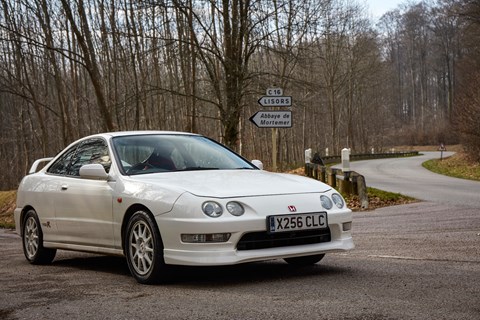
There was a bit of jumping between models here but we got hold of the most focused driver’s car for a decent stint on windy roads linking farms and villages near Rouen, and found it extremely hard to hand back. The experience is a hard one to sum up because it’s so raw, so visceral.
There’s barely any sound deadening between you and the 1.8-litre engine that so utterly dominates the drive, so the first thing you’ll notice is the noise. Even at low speeds it’s metallic and so angry – less Type R, more Type Arrrghhhhh.
Keep your foot in to unlock peak power of 188bhp at 7900rpm and it sounds like you’re chainsawing your way out of a shipping container full of wasps. The VTEC comes in with a frenetic sprint to the redline at a point in the rev range where the engine has absolutely no right to find more speed – like Mo Farah on the last lap of the 10,000 metres.
The steering is heavy but feels utterly dialled in to the front tyres so it’s easy and fast to build a lot of confidence in the front axle. All the control points are just so nice to use – the wheel spins with linear weighting and zero slack and the gearstick slots into each ratio with clockwork precision.
In short it’s an absolute joy to drive – there is a lot of hype surrounding it and on this occasion it’s entirely justified. Don’t let anyone tell you a four cylinder engine means inferior noise and performance – we’d have this unit over countless current turbo’d sixes and eights.
Not really a motorway car
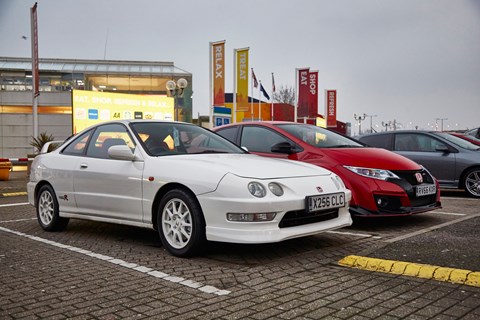
We spent half of our time in the Integra on the windy forest road and the other half on the Autoroute to Calais. No surprises that it didn’t shine as brightly during the latter half. The five speed gearbox means the engine sits perilously close to the VTEC at motorway speeds and not even the aftermarket stereo could drown it out – certainly makes overtaking easy though.
Still, long-distance cruising is not really what the Integra is for, and what you lose in refinement you more than gain in sheer excitement. It’s one of the all-time greats, this car.
Dover to Peterborough: Civic Type R (EP3)
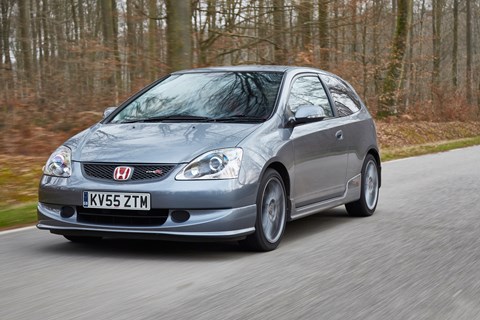
The home leg of any trip to France is usually a bit rubbish – dreary miles on the cracked and battered M20 (the millpond-smooth Autoroute a distance memory) an inevitable and endless traffic jam, plus in our case some threatening looking snow.
None of these things should have played to the Civic’s strengths but somehow it managed to charm us more than any other car on this trip. It offers 80% of what the Integra does with the added benefit of a sixth gear and just a little bit of sound proofing.
The gearshift is mounted high near the wheel, jutting out of the dashboard and slicing through the gate with oily exactitude. The power delivery is nearly as frenzied as the Integra, to the point where our car kept spinning its wheels at 6000rpm on a wet road in second gear.
It sounds great too – howling and metallic when pushed but equally quiet when cruising. The only weak link really is the electric power steering. It’s not horrendous but doesn’t offer the same feedback as the other cars here, relinquishing its weight alarmingly mid-bend in response to the tyres reaching their limit of grip.
Which one should I buy?
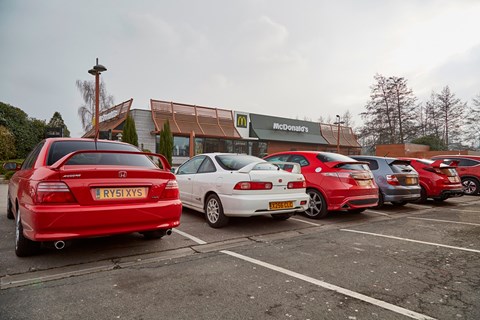
Money being no object you should immediately buy an Integra because it’s superb in all the ways that modern cars simply aren’t any more. That said, the less-shouty Accord won a lot of affection for its understated nature and easily deployable power. Plus it looks seriously cool.
If you want a Civic the choice is less clear. The knee-jerk reaction would be to buy an EP3 – it’s a great drive, reliable, and can be picked up for peanuts if you don’t mind an early example. The FN2 offers much of the same with slightly less of a boy racer image, plus a diff in later models if you’re a bit of a helmsmith.
The FK2 Civic is a bit of an odd one out here – but that doesn’t make it a bad buy, particularly if you can get hold of a decent deal before the fourth generation car lands. Just stay away from kerbs.
Click here to read CAR’s long-term test living with a Honda Civic Type R FK2